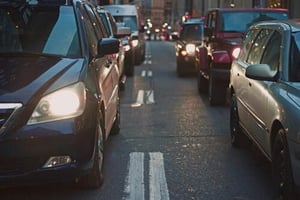Decoding Car Insurance in London: A Guide for Learners and New Drivers Learning to drive is an...
What to do if you see or hear an emergency vehicle?
What to Do When You Hear Sirens or See Flashing Lights While Driving in London
Driving in London’s busy streets can be challenging, especially when an emergency vehicle with flashing lights and sirens approaches. With bus lanes, cycle lanes, red routes, and congestion zones to consider, knowing how to react safely and efficiently is crucial. Here's a guide to help you navigate these situations while staying compliant with traffic rules.

Stay Calm and Alert
The first rule when encountering an emergency vehicle is to stay calm. Panicking can lead to sudden, unsafe decisions that endanger you and others. Look ahead, check your mirrors frequently, and listen for sirens so you can anticipate the vehicle's approach.
Steps to Take When You See or Hear Emergency Vehicles
1. Assess the Situation:
Identify where the siren or flashing lights are coming from—behind, ahead, or from a side street.
Avoid abrupt stops or swerves that could confuse other drivers.
2. Make Way Safely
Pull over to the left if it’s safe and legal to do so. Avoid stopping near bends, junctions, or narrow roads where visibility is limited.
Never mount the pavement or stop in cycle lanes unless absolutely necessary.
3. Respect Basic Traffic Rules:
Do not enter bus lanes, red routes, or box junctions unless directed by the emergency vehicle or it’s clear and safe.
Avoid stopping on red routes where stopping is prohibited unless there’s no alternative.
4. Be Mindful of Cyclists and Pedestrians:
Check for cyclists or e-scooters before changing lanes or pulling over.
Be cautious of pedestrians who may step into the road to observe the emergency vehicle.
5. Do Not Tailgate:
Once the emergency vehicle has passed, do not follow closely behind it to take advantage of cleared traffic. This is illegal and dangerous.
Navigating London’s Specific Challenges
Bus Lanes
Bus lanes are strictly regulated in London. Do not enter them unless signs indicate it’s permitted at that time. Emergency vehicles will often use bus lanes themselves, so stay out of their way without entering restricted areas.
Cycle Lanes
London has an extensive network of cycle lanes. Avoid pulling into these spaces as they are often occupied by cyclists who may not expect a stationary car in their path.
Red Routes
Red routes prohibit stopping at any time (double red lines) or during specified hours (single red lines). Only stop if it’s absolutely necessary for the emergency vehicle to pass safely.
Congestion Zones
While congestion zones don’t directly affect your reaction to emergency vehicles, always be aware of your surroundings as these areas are typically more congested with pedestrians and cyclists.
Why Staying Calm Makes You a Better Driver
Reacting appropriately to emergency vehicles not only helps save lives but also improves your driving skills in the long run. Navigating high-pressure situations like these enhances your hazard perception, decision-making, and overall awareness—skills that are invaluable for driving in London’s busy streets.
By staying alert and following these steps, you’ll ensure that emergency services can perform their duties efficiently while keeping yourself and others safe on the road.




